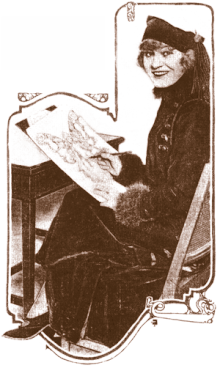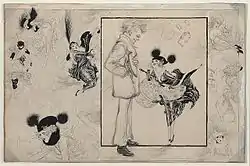Nell Brinkley
Nell Brinkley (September 5, 1886 – October 21, 1944) was an American illustrator and comic artist who was sometimes referred to as the "Queen of Comics" during her nearly four-decade career working with New York newspapers and magazines. She was the creator of the Brinkley Girl, a stylish character who appeared in her comics and became a popular symbol in songs, films and theater.
Nell Brinkley | |
|---|---|
 | |
| Born | September 5, 1886 |
| Died | October 21, 1944 (aged 58) |
Background and career
Nell Brinkley was born in Denver, Colorado in 1886 (some sources say 1888), but her family soon moved to the small town of Edgewater on Denver's western border, facing Sloan's Lake at Manhattan Beach. As a small child, she drew place-setting illustrations of knobby-kneed kiddies for Mary Elitch's garden parties at Elitch Gardens. She had no formal arts training, and dropped out of high school to pursue a career in illustration.[1] She did cover and interior illustrations for the 1906 children's book, Wally Wish and Maggie Magpie by A.U. Mayfield.[2] She did pen-and-ink drawings for The Denver Post and the Rocky Mountain News.
Brinkley was scouted in 1907 by media mogul William Randolph Hearst and his editor Arthur Brisbane, who convinced her to move from Denver to Brooklyn, New York where Heart's newspaper empire was centered. She was accompanied by her mother. She worked in Manhattan for the Journal, where she produced large detailed illustrations with commentary almost every day. Her art was featured in the prestigious magazine section, and the newspaper's circulation boomed. Brinkley later moved to New Rochelle, New York, a well known artist colony, home to many of the top commercial illustrators of the day.[3] She soon became well known for her breezy and entertaining creations. The curly-haired everyday working-girl drawings were known as the Brinkley Girl, who soon upstaged Charles Dana Gibson's Gibson Girl. The Ziegfeld Follies (1908) used the Brinkley Girl as a theme, and three popular songs were written about her. Bloomingdale's department store featured a Nell Brinkley Day with advertisements using many of her drawings. Women emulated the hairstyles in the cartoons and purchased Nell Brinkley Hair Curlers for ten cents a card. Young girls saved her drawings, colored them and pasted them in scrapbooks. The Denver Press Club greeted her when she vacationed in Colorado in the summer of 1908. Nell was most famous for her representing "relationships between boy and girl—man and woman—Bettys and Billies." Her illustrations used the drawing of "Dan Cupid" to represent the presence of that something most people call "love".
Brinkley's reputation was also established by an early assignment to cover the sensational murder trial of Harry K. Thaw. She was assigned many interviews with the actress-wife, Evelyn Nesbit. In later years, she covered other infamous murder trials. She produced numerous courtroom illustrations printed in the Evening Journal and other Hearst newspapers.[4]
Brinkley had been on the staff of the Journal for only three months when the new trial began. She had come after two years on the Denver Post, bringing with her a talent for pretty-girl art that had not yet been matured into delicately fine-lined art-nouveau style for which she would become famous.[1] Brinkley christened all the pretty girls she drew "Betty," and called all the boys "Billy".[1] Brinkley's debut came on November 26, 1907 and she was featured on a comics page that contained her illustrated panel that accompanied an article on actress Valeska Surrat. Brinkley wrote this article using her usual superlatives ("The Most Beautiful Woman I Ever Saw"), and her next day's subject was Ethel Barrymore.[1]
After the Thaw trial, Brinkley returned to the women's page and made forays into the entertainment section with reviews of new plays and musicals.[1] Brinkley's art was now featured in Hearst newspapers all over the country and Americans were sitting up and taking notice of this new young artist.[1]
Brinkley wrote in the pop culture style of the early 20th century, producing breathless prose filled with run-on sentences, liberally sprinkled with dashes.[1]
Brinkley flew with Glen Martin in his new biplane and reported the daring swoopings and the landing for her readers. Brinkley helped with War Bond drives, and she entertained and consoled those at home and the American youth abroad, during and just after World War I. She traveled to Washington, D.C. where she interviewed many young ladies who had left their homes to become defense workers.[2]
.jpg.webp)
Brinkley also became known for the charming text that accompanied her stories and reporting while she worked at the Evening Journal and other publications that included Cosmopolitan, Good Housekeeping and Harper's Magazine. She produced many illustrated theatre reviews and profiles of mothers and young women in society, including later, in the 1930s First Lady Eleanor Roosevelt.[1] Much of her writing promoted the working women of the time, and encouraged the expansion of women's rights.
Her work was distributed to newspapers internationally by King Features Syndicate and Brinkley became the most prolific and famous romantic writer-illustrator. Later, she illustrated books and produced topical multi-panel pages of art. One was collected in a 1943 anthology of comics.
By 1935, however, photography began to replace illustrations in newspapers, and she began to lose popularity.
In 1944, Nell Brinkley died after over 30 years of entertaining fans from the "most read newspapers". Her death went largely unnoticed under the crush of WWII news, but The Associated Press reported she passed in a New Rochelle hospital on the night of October 21, 1944 after a long illness.[5] Brinkley, her mother and father are all buried in a New Rochelle, New York cemetery.
In 2020, The San Diego Comic Con inducted Nell Brinkley into the Eisner Award Hall of Fame.[6]
The Brinkley Girl
Brinkley was known for her idyllic designs in her artwork, and her female characters drew attention from readers. In comparison to the staid Gibson Girl stereotype established earlier by Charles Dana Gibson, the Brinkley Girl was feminine, fun-loving and more independent.[1] Syndicated nationally, her drawing The Three Graces helped establish this character as an icon. The piece, displaying three women singing the praises of suffrage, preparedness and Americanism with regards to love of country, was one of the first to link young, attractive women with the concept of suffrage.

The Brinkley Girl was generally a young working woman who was often seen wearing lacy dresses and wearing her hair in curls, engaged in activities that were more independent than the general female standard. Her work was often considered to have a feminist slant.[7]
The Brinkley Girl became a national sensation, the topic of pop songs, poetry and theater. The second Ziegfeld Follies (1908) featured a number of references to the Brinkley Girl, including a song "The Nell Brinkley Girl" by Harry B. Smith and Maurice Levi.[8][9]
Books
.jpg.webp)
The Brinkley Girls (Fantagraphics Books, 2009) collects Brinkley’s full-page color art from 1913 to 1940; her earliest adventure series, Golden Eyes and Her Hero, Bill; her romantic series, Betty and Billy and Their Love Through the Ages; her flapper comics from the 1920s; her 1937 pulp magazine-inspired Heroines of Today and unpublished paintings, along with an introduction by the book's editor, Trina Robbins.
Her earliest series, Golden Eyes and Her Hero, Bill, is a comic chronicling the adventures of a girl known as Golden Eyes during World War I.[10] It ran from March 1918 through February 1919 and featured full page illustrations in color. The series was renamed "Golden Eyes" and Her Hero "Bill" Over There, after a few episodes (as the narrative had shifted to France) and would keep that new name for the remaining 15 installments.[10]
The story begins with Golden Eyes saying goodbye to her lover Bill, who is deployed to France to fight the Germans. He leaves his faithful dog "Uncle Sam" in her care, and while girl and dog try to do their part for the allies from home they're spurred into action by the discovery of a German spy in Golden Eyes' own backyard.[10] Golden Eyes, with Uncle Sam at her side, enlists as an ambulance driver for the Red Cross, and they are briefly reunited with Bill in France before duty separates them again.[10] Golden Eyes, the dog, and Bill are reunited and drawn apart repeatedly throughout the course of the tales. They rescue each other from capture and injury as they fight for the allies - and for their future together.[10]
The serial is notable for its proactive heroine, patriotic underpinnings, and distinct Brinkley art style which blended elements of Art Deco and Art Nouveau into elegant, sumptuous illustrations that embodied the ideals of feminine beauty in the 1910s.
Her last published work was a Sunday series begun in 1937 entitled, Heroines of Today. This is considered Brinkley's most interesting and powerful creation.[1] Intended to glamorize women from many walks of life, both in household work and outside it, married or single, Brinkley portrayed strong women workers like forest-fire spotters, soldiers, police detectives, a woman who acts as rescuer when saving four people from drowning, and a "jungle queen" who was left to survive on her own after her trader husband dies: she is depicted heroically continuing his business while working altruistically with indigenous people.[1]
Her "Woman Warrior" illustrations were featured in the Heroines stories. Brinkley wrote of women in action during WWII, using machine guns and operating tanks in Soviet Russia, and in Spain.[1] A notable story was that of Rosetta Millington of Austria, a Red Cross worker who joined the Spanish Foreign Legion during WWII disguised as a man.[1]
Further reading
- Collins, Lois E.; Tom J. Collins. Nell Brinkley 1917 "Love Letters". Retrieved 2009-07-30.
- Collins, Lois E.; Tom J. Collins. Nell Brinkley 1918 "Love Letters". Retrieved 2009-07-30.
- Collins, Lois E.; Tom J. Collins. Nell Brinkley 1919 "Love Letters". Retrieved 2009-07-30.
- Trina Robbins, ed. (2009). The Brinkley Girls: The Best of Nell Brinkley's Cartoons from 1913-1940. Fantagraphics Books. ISBN 978-1-56097-970-8.
References
- "Nell Brinkley: A New Woman in the Early 20th Century" Accessed November 10, 2007.
- Collins, Lois and Tom, Nell Brinkley 1917 1918 and 1919 "Love Letters" Archived 2009-02-02 at the Wayback Machine, nellbrinkley.net: Accessed November 11, 2007.
- "New Rochelle - Arts City". Archived from the original on 2018-09-06. Retrieved 2015-02-21.
- Robbins, Trina, &ots=_A0UNuNy5S&sig=zcNmo5uUj3WcZVywT607C1f52oA#PPA9,M1 Nell Brinkley and the New Woman in the Early 20th Century, page 9. Accessed through Google Books November 10, 2007.
- Associated Press, “Nell Brinkley Dies”, The San Bernardino Daily Sun, San Bernardino, California, Monday 23 October 1944, Volume 51, page 1.
- https://www.comic-con.org/awards/eisner-awards-current-info
- Prieto, Laura, At Home in the Studio: The Professionalization of Women Artists in America, page 173. Accessed through Google Books November 10, 2007.
- Robbins, Trina, &ots=_A0UNuNy5S&sig=zcNmo5uUj3WcZVywT607C1f52oA#PPA9,M1 Nell Brinkley and the New Woman in the Early 20th Century, page 22. Accessed through Google Books November 10, 2007.
- Ziegfeld Follies of 1908, Internet Broadway Database. Accessed November 10, 2007.
- Leporidae. "Comic Book / "Golden Eyes" And Her Hero "Bill"". TV Tropes.
External links
- The Ohio State University Billy Ireland Cartoon Library & Museum: "Nell Brinkley" digital exhibit
- Exhibition at cartoon art museum
 Media related to Nell Brinkley at Wikimedia Commons
Media related to Nell Brinkley at Wikimedia Commons